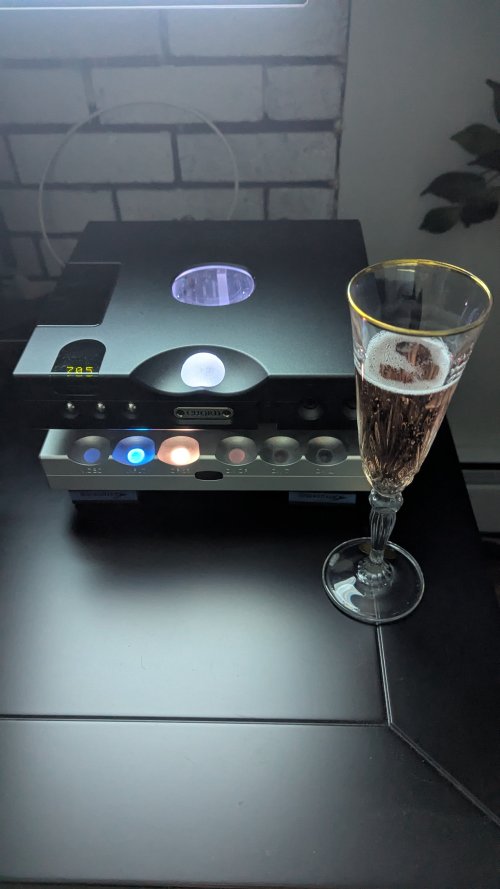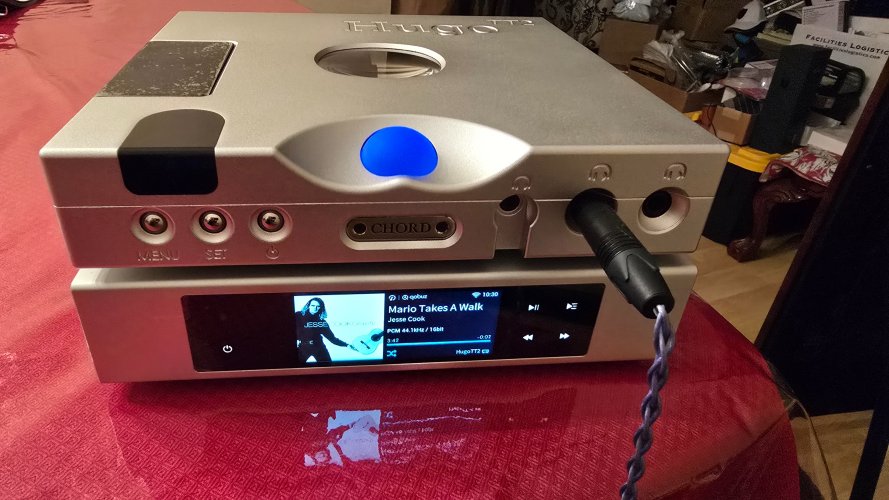Another reason to use optical is that many of the high frequencies in high-res music that are above 48 khz (the limit of a 96 kHz file) just consist of noise generated by the ADC used in recording, and are not actual musical content. So, all that space taken up by 192k or better tracks is half noise! It makes more sense to go no higher than 24/96, and that will play readily over an optical connection.
Latest Thread Images
Featured Sponsor Listings
You are using an out of date browser. It may not display this or other websites correctly.
You should upgrade or use an alternative browser.
You should upgrade or use an alternative browser.
Hugo TT 2 by Chord Electronics - The Official Thread
- Thread starter ChordElectronics
- Start date
Thanks for this. What do you think about analogue audio transferred into hirez pcm? Do you think that 24/96 is still the sweet spot?Another reason to use optical is that many of the high frequencies in high-res music that are above 48 khz (the limit of a 96 kHz file) just consist of noise generated by the ADC used in recording, and are not actual musical content. So, all that space taken up by 192k or better tracks is half noise! It makes more sense to go no higher than 24/96, and that will play readily over an optical connection.
jarnopp
Headphoneus Supremus
- Joined
- Nov 26, 2014
- Posts
- 2,423
- Likes
- 1,780
Sorry to take so long to reply…forgot for a bit! But, YES, this is exactly how the adapter Moon Audio made for me is wired. I have used it without issue.Can some expert advice if the image below would show the correct pin wiring for an dual 3-pin XLR to 4-pin XLR adapter cable to be used with the TT2?
Was already searching within this thread but found not a 100% confirmation to this (besides only to use pins 2 and 3 for balanced signal)
nwavesailor
Headphoneus Supremus
- Joined
- Nov 14, 2009
- Posts
- 3,954
- Likes
- 5,706
Probably 24/48, even though there's nothing really up at the higher frequencies to capture, let alone the dynamic range for 24 bit (you'll be lucky to get 12-14 bit I think). I'd only capture at 24 bit for the sake of having room for post-processing (eg: noise reduction) and the like.Thanks for this. What do you think about analogue audio transferred into hirez pcm? Do you think that 24/96 is still the sweet spot?
Why does the TT2 have -/+ volume levels?
eg: +1 L/H means it's overdriving the volume level beyond the maximum volume (which would be 0 L/H)?
eg: +1 L/H means it's overdriving the volume level beyond the maximum volume (which would be 0 L/H)?
Compared to mqa on tidal qobuz at 96 and 192 khz sounds very fine to me. Also hires qobuz sounds excellent compared to redbook qobuz on same albums. So whatever qobuz are doing they are doing it right IMHO. The hires has an instantly noticeable expansion of soundstage and depth and detail. One has to ask themselves are these original recordings or processed but the real question is if it provides a real increase in listening enjoyment does it really matter? Certainly nothing is being taken away from the music with qobuz hires so do I really care? Answer no.
For me without the mscaler we return to a 2 dimensional presentation of the music and the mscaler instantly transforms the musical presentation back to a 3 dimensional one. Hence why I chose an mscaled tt2 over a solo Dave. An mscaled Dave was not right for me with cost being only one of many considerations.
Wishing all headfiers around the world and in the UK, Rob and everyone at chord a great 2022. MK
For me without the mscaler we return to a 2 dimensional presentation of the music and the mscaler instantly transforms the musical presentation back to a 3 dimensional one. Hence why I chose an mscaled tt2 over a solo Dave. An mscaled Dave was not right for me with cost being only one of many considerations.
Wishing all headfiers around the world and in the UK, Rob and everyone at chord a great 2022. MK
Last edited:
bpcans
Headphoneus Supremus
@musickid, if I was forced to then maybe, just maybe, I could live with a DC4/DAVE plus an M Scaler. But until that lottery ticket pays off I’ll just have to suffer through.
Amberlamps
Formerly known as Phuca
Why does the TT2 have -/+ volume levels?
eg: +1 L/H means it's overdriving the volume level beyond the maximum volume (which would be 0 L/H)?
I’ve still got to wrap my head around decibels and how it all translates in to real world speak. + and - huh, TT2 is the first device that I’ve ever had that gets louder when the screen shows - x
One day I will give a schit about it and read up about how it will make my life better, but the chances are extremely high that I won’t.
My TT2 displays red colour when connected via USB ( DAC mode out putting via XLR into A90 AMP).
On Windows, closing iTunes and then restarting the TT2, the color turns blue (as it should I presume). But on the Mac it remains red even though it outputs sound just fine.
What’s going on ?
On Windows, closing iTunes and then restarting the TT2, the color turns blue (as it should I presume). But on the Mac it remains red even though it outputs sound just fine.
What’s going on ?
Yeah well, I solved the volume setting confusion by using an external amp and letting whatever defaults the TT2 uses in Dac mode. The amp has the less confusing 0 to max volume knobI’ve still got to wrap my head around decibels and how it all translates in to real world speak. + and - huh, TT2 is the first device that I’ve ever had that gets louder when the screen shows - x
One day I will give a schit about it and read up about how it will make my life better, but the chances are extremely high that I won’t.
My TT2 displays red colour when connected via USB ( DAC mode out putting via XLR into A90 AMP).
On Windows, closing iTunes and then restarting the TT2, the color turns blue (as it should I presume). But on the Mac it remains red even though it outputs sound just fine.
What’s going on ?
It's the sample rate. Red is the most common as it's the usual 44.1 khz for music. See the manual. Blue is a higher rate, likely due to Windows upsampling which should be disabled.
Oh man ok. So in windows I should let run as default res (32 bit 44 kHz ) in the sound properties and let TT2 handle the upscaling ?It's the sample rate. Red is the most common as it's the usual 44.1 khz for music. See the manual. Blue is a higher rate, likely due to Windows upsampling which should be disabled.
Oh man ok. So in windows I should let run as default res (32 bit 44 kHz ) in the sound properties and let TT2 handle the upscaling ?
I do this for my two optical outputs and for USB (but I only use USB when updating the firmware on my RME).

Others could correct me if this is wrong or there is a better way to disable the annoying automatic up-sampling in Windows.
My doubt is: what happens with video? Should one technically go in and change manually to 48khz when watching a movie (not that I ever do in fact)?
You could try disabling undesirable frequencies in the ‘supported formats ‘ tab.I do this for my two optical outputs and for USB (but I only use USB when updating the firmware on my RME).
Others could correct me if this is wrong or there is a better way to disable the annoying automatic up-sampling in Windows.
My doubt is: what happens with video? Should one technically go in and change manually to 48khz when watching a movie (not that I ever do in fact)?
Also I think windows will switch to 48kHz when playing video. The TT2 does default to 44.1
Problem is : Apple lossless goes upto 24bit 192 kHz. In which case, again let Windows output 44.1 kHz ?
Last edited:
Users who are viewing this thread
Total: 26 (members: 0, guests: 26)




























